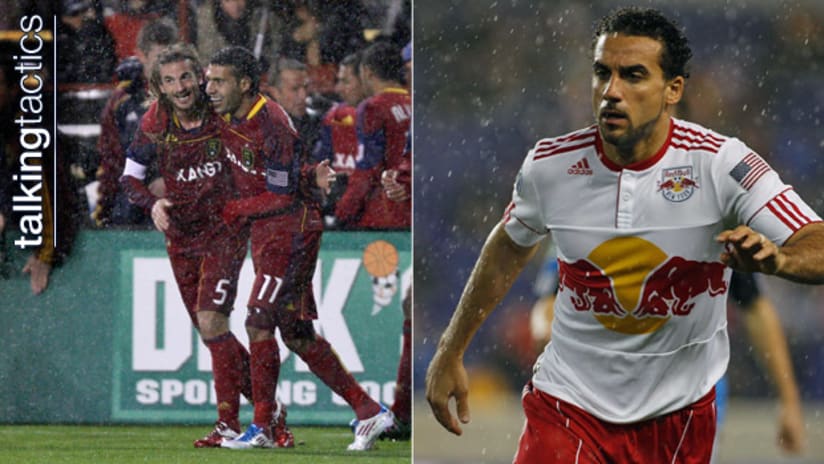Two prominent MLS sides drive forward behind diamond-shaped midfields. Jason Kreis has Real Salt Lake aiming for historic heights with a midfield diamond. And Hans Backe has a midfield diamond whirling at Red Bull Arena—a midfield that that may finally have arrived at full rev over the weekend in a convincing win over San Jose.
But every diamond-shaped midfield in a 4-4-2 formation certainly is not the same. To presume so would be like telling a wine lover that every pinot noir is the same.
[inlinenode:333694]Barring some unseen tactical gimmick, due to the heat or something else, RSL will attack Monterrey in Wednesday’s CONCACAF Champions League final opener (10 pm ET, FOX Soccer, TeleFutura) with their true-blue 4-4-2. Kyle Beckerman will sit deep, Ned Grabavoy or Andy Williams will deploy wide right, Will Johnson will chew up the ground to the left, and Javier Morales will operate on top of it all
But, as we’ve noted before, a reliable compactness is the very essence of their RSL diamond. On defense, it’s the most compact midfield in MLS, with all four players working constantly to close off passing lanes and pressure from appropriate angles.
On the attack, RSL dote on their careful spatial arrangements, fluidly maintaining the balance of precise separation, just far enough apart and just close enough together. Generally speaking, RSL midfielders move in reaction to the position of the ball. (So does the entire team, of course, but we’re talking about midfielders here.)
The Red Bulls work their diamond differently. The midfielders arrange themselves just so, then let the ball find them. It’s all about spacing there, too—but in a very different way.
Whereas the RSL diamond is about being compact, the Red Bull diamond looks like a bunch of players who don’t really like each other. That is, as you’ll see when New York travel to D.C. United on Thursday (8 pm ET, ESPN2), they go their separate ways.
[inlinenode:333632]Teemu Tainio holds. Joel Lindpere is on the left, but generally tucked inside. Dane Richards is on the right. Way on the right. And Dwayne DeRosario’s starting position is about 20-30 yards ahead of Tainio, not particularly close to either Richards or Lindpere.
As the sequences evolve, the New Yorkers find themselves in and out of closer proximity. But it really is something to watch the Red Bulls’ starting positions, to see them initiate movement by stretching defenses all over the park. With starting positions dispersed so, it becomes quite problematic for opposition defenses to keep the compact shape they desire.
Richards’ speed and ability to slice by defenders one-on-one is a primary reason Backe wants to go these separate ways. Richards’ abilities are so important for the Red Bulls, Backe even considered playing in a modified 4-3-3 this year, acknowledging that he had only one truly “wide” player (Richards) and proclaiming the critical importance of exploiting the Jamaican speedster’s flank prowess.
Ironically, the essential component actually lies outside the midfield. It’s about the silky smooth passing from center backs Tim Ream and Rafa Márquez. Both are comfortable zipping 30- or 40-yard connections into Tainio, Lindpere or Richards. That means Tainio can set up further upfield than many holding midfielders. That, in turn, pushes Richards, Lindpere, and DeRosario further up the field, which further stresses and stretches defenses.
(If defenses press up too far in attempts to compress all the space, Ream and Marquez can play over the top.)
[inline_node:328620]So it becomes very difficult for opposition midfielders to properly cover the vast defensive space. With such efficient, accurate passing out of the back, marking closely isn’t good enough. The divide between each Red Bull attacker means Marquez or Ream can simply aim balls left or right of the target; there’s plenty of room available for teammates to maneuver a few yards to collect passes and move the play forward from there.
At RSL, the preferred passing and spacing distance is 15-or-so yards. Around Red Bull Arena, that distance is closer to 25-30 yards.
The Red Bull way breaks down slightly as they all get closer to goal, as the spaces compress and defenses can regain a compact structure. It’s like an NFL run-and-gun stumbling and misfiring in the condensed space of the red zone.
But as New York players get more comfortable with this arrangement, and as DeRosario gets confirms with his starting positions, they’ll better know the angles of attack and the optimal timing of it all—which is what we started to see over the weekend in the big win over San Jose. And we will see again on Thursday.



